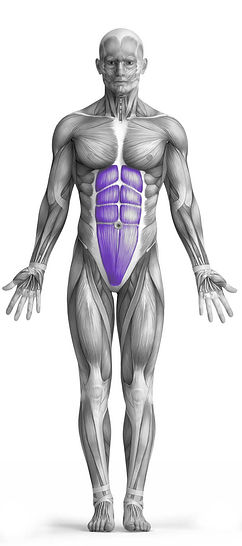Reach Crunch 101 Video Tutorial
0

Exercise Synopsis
Target Muscle Group
Abs
Secondary Targets
Execution
Isolation
Force Type
Core
Required Equipment
Bodyweight
Fitness Level
Intermediate
Variations
None
Alternatives
Timer
Hour
Minute
Second
Stopwatch
00:00:00:00
Overview
The Reach Crunch is an effective bodyweight exercise designed to strengthen and tone the abdominal muscles, with a primary focus on the rectus abdominis and secondary engagement of the obliques. To perform this exercise, lie on your back with your knees bent and feet flat on the floor. Extend one arm overhead while reaching towards the opposite knee as you perform a crunch, engaging your core to lift your shoulder blades off the ground. This motion helps enhance core stability and abdominal strength without the need for additional equipment.
How to Perform
Starting Position: Lie on your back on a flat surface, such as a mat or carpet. Bend your knees and place your feet flat on the floor, hip-width apart. Rest your arms alongside your body.
Arm Positioning: Extend one arm straight above your head, keeping it close to your ear. This will be the arm that reaches towards the opposite knee.
Engage Core: Tighten your abdominal muscles and press your lower back into the floor. This will stabilize your core and prepare you for the movement.
Initiate Crunch: As you exhale, lift your shoulders and upper back off the floor by engaging your abs. Simultaneously, reach the extended arm towards the opposite knee. Keep your gaze focused on your reaching hand to ensure proper form.
Reach and Hold: At the peak of the crunch, your shoulder blades should be elevated off the floor, and your reaching arm should be close to or touching the opposite knee. Hold this position briefly, squeezing your abs and obliques.
Return to Start: Inhale and slowly lower your shoulders back to the floor while extending your arm back to the starting position. Maintain control throughout the descent to maximize effectiveness.
Repeat: Perform the desired number of repetitions on one side, then switch arms and repeat the exercise on the other side.
Cool Down: After completing the sets, gently stretch your abdominal muscles to help with recovery and flexibility.
★ Bonus: For exercises that involve external weights (such as dumbbells, barbells, or machines), the One Rep Max (1RM) calculator can help you estimate your maximum lifting capacity. Use it to track your strength progress and adjust your training for optimal results.
Tips
Keep your lower back pressed into the floor throughout the exercise.
Engage your core before lifting your shoulders off the ground.
Extend one arm straight above your head while the other arm is bent by your side.
Lift your shoulders and upper back while reaching the extended arm towards the opposite knee.
Keep your gaze focused on your reaching hand to maintain proper form.
Squeeze your abs and obliques at the top of the crunch.
Lower your shoulders back to the floor in a controlled manner.
Perform the exercise slowly to maximize muscle engagement and avoid momentum.
Switch arms and repeat to ensure balanced activation of both sides.
Avoid pulling on your neck; use your abs to lift your shoulders.
How Not to Perform
Avoid Pulling on the Neck: Do not use your hands or arms to pull on your neck. This can strain the neck muscles and reduce the focus on your abs. Keep your hands by your sides or gently placed behind your head for support.
Don’t Arch Your Lower Back: Ensure your lower back remains pressed into the floor. Avoid arching it, as this can lead to lower back strain and reduce the effectiveness of the exercise.
Avoid Using Momentum: Do not rely on momentum to lift your shoulders. Perform the movement slowly and deliberately to engage the abs and obliques fully.
Don’t Overextend Your Arm: Avoid reaching too far with your extended arm. Overextending can compromise form and reduce the effectiveness of the exercise.
Prevent Leg Movement: Keep your legs stable and avoid excessive movement or lifting. The focus should remain on the crunch and not on using the legs to assist.
Avoid Incomplete Range of Motion: Ensure you fully lift your shoulders off the floor and reach towards the opposite knee. Incomplete range of motion can minimize muscle engagement.
Don’t Rush the Exercise: Perform the Reach Crunch at a controlled pace. Rushing can reduce muscle activation and increase the risk of injury.
Avoid Arching the Upper Back: Keep your shoulder blades off the ground, but don’t excessively arch your upper back. Focus on using your core muscles to lift.
Don’t Hold Your Breath: Remember to breathe throughout the exercise. Holding your breath can reduce core engagement and make the exercise less effective.
Avoid Excessive Neck Flexion: Keep your neck in a neutral position, and don’t excessively flex it. This helps to prevent neck strain and maintain focus on the abs and obliques.
Variations
Variations of fitness exercises refer to different ways of performing a specific exercise or movement to target various muscle groups, intensities, or goals. These variations aim to challenge the body differently, prevent plateaus, and cater to individuals with varying fitness levels.
Alternatives
Alternative exercises in fitness refer to different movements or activities that target similar muscle groups or serve the same training purpose as the primary exercise. These alternative exercises can be used as substitutes when the original exercise is unavailable or challenging to perform due to various reasons such as equipment limitations, injuries, or personal preferences.








